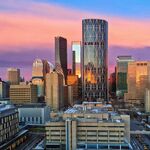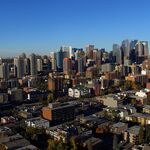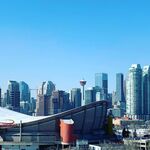CBBarnett
Senior Member
The mid-NE is one of three big 70s developed clusters, along with one in the NW along Crowchild and one in the S along Anderson as well as smaller ones in the Beddington and Riverbend areas. But the mid-NE continues to have a consistent density of toddlers throughout - even though the first map is from 2006 when these communities are 25+ years old. A consistent density is exactly what makes schools the most efficient to operate (if they are provided for at least), and a higher density of toddlers means (again if the schools are provided for) more kids who can walk to school. Part of it is population density; the mid-NE has ~3-4K people per sq km while the other areas are more like ~2-3K. But a big part of it is actually having more toddlers per capita; here's the percent of 0-4 year olds from 2021:
Lots of variables are correlated, but there's a few stories we can probably tease out. Income and housing affordability seems to be a big thing in the long-run trends of toddler density.The Properties area also home to a lot of new immigrants which typically have larger families.
In particular, which places have maintained some relative affordability, and which have not over the past 30 years. My hypothesis, acknowledging it's not a one-fit-all scenario, but a generalization:
- toddlers are mostly in young families, parents typically in the early or mid careers.
- Adults in their early or mid careers usually have lower incomes than older working adults further along in their careers. Less money for downpayments or rents.
- Areas where housing has become expensive over 30 years will see a decline in young families, and therefore a decline in toddlers.
A few locations that stand out with some possible rationale:
- Sustained, high toddler density in West Downtown/Beltline: continual high density of toddlers due to affordability and unit density. It's the cheapest and oldest cluster of apartment blocks in the city and have existed since the 1970s. It's an affordable place to start for many, likely only for a while before moving elsewhere in the city. But the continual affordability is the key - a new young family replaces the old one when they move out. Keeps toddler density high in perpetuity - essentially the area is gentrification-proof thanks to a rare cluster of significant volume of older building stock.
- 1970s, 1980s and 1990s North, West and South burbs decline, toddlers move to new communities further out - these areas are all $800K - $1M+ for housing now. Perhaps not surprisingly, these have mostly followed a patterns of having kids when they were affordable (1970s/1980s) and less and less as time goes on and the neighbourhood ages. Fewer young families can afford here, while new housing of smaller and cheaper formats is rare.
- Northeast older burbs is the exception - likely due to maintaining some level of relative affordability, especially compared to similar areas elsewhere. Housing seems to turn-over as people move, with new toddler families moving in.




